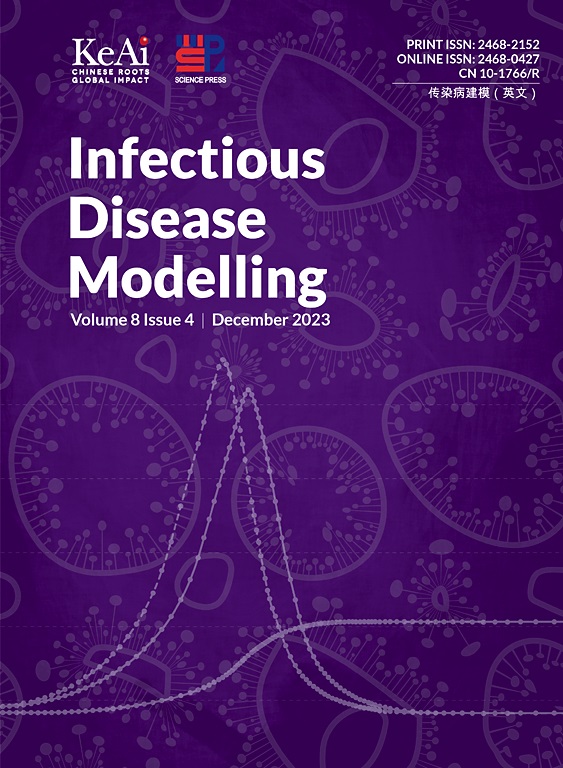Ring vaccination and vector control as control strategies for potential yellow fever outbreak in an Asian city
IF 2.5
3区 医学
Q1 Medicine
引用次数: 0
Abstract
Background
Yellow Fever (YF) importation remains an active risk to Southeast Asia. This study aims to determine the effectiveness of vector control and ring vaccination as containment strategies.
Methods
We modelled a YF outbreak in Singapore over 1 year using a metapopulation vector-host spatial model to explore the impact of a potential epidemic and intervention effectiveness. 30 different scenarios were examined by varying the vector to human ratio m ([1, 3, 6]), vaccination coverage ([10 %, 50 %, 90 %]) and delay in vaccine rollout ([7, 14, 30 days]), including three non-vaccination scenarios with the vector-to-human ratio m ([1, 3, 6]).
Results
Vector control has a significant protective effect with an 89 % reduction in the cumulative number of exposed cases at Day 365 when lowering m from 6 to 1 in the baseline scenario without ring vaccination. Vaccination coverage levels of 90 %, 50 %, and 10 % reduce the cumulative number of exposed cases by 88 %, 56 %, and 12 %, respectively, compared to baseline, when fixing m = 3 and a 7-day rollout delay. A greater number of severe infections and deaths can be mitigated by decreasing the ratio m compared to ring vaccination strategies. The marginal gains in averting the number of infections and deaths are most significant when m is decreased, followed by increased vaccination coverage and reduced intervention delay as R0 is proportional to . This highlights the central role of vector control. Our findings suggested that ring vaccination is effective under lower mosquito-to-human ratios up to 1-week post-detection, with vaccination coverage of at least 50 %. Under these settings, vaccine doses equal to 25 % of the total population are needed to contain the initial outbreak, allowing time to monitor its progress and restock the supply. After that, further interventions where YF has not yet been declared endemic.
Conclusion
Our findings suggested that ring vaccination is effective under lower mosquito-to-human ratios up to 1-week post-detection, with vaccination coverage of at least 50 %. After that, further interventions are required to bring the effective reproduction number Reff under 1, highlighting the need for rapid response and containment, preparation in the stockpiling of vaccines, and continual suppression of mosquito vector populations when faced with the risk of YF importation and outbreak.
将疫苗接种和病媒控制作为亚洲某城市潜在黄热病暴发的控制策略
背景:黄热病(YF)输入对东南亚仍然是一个活跃的风险。本研究旨在确定媒介控制和环形疫苗接种作为遏制策略的有效性。方法我们使用一个超种群媒介-宿主空间模型对新加坡1年的YF暴发进行建模,以探索潜在流行病的影响和干预效果。通过改变病媒与人的比例m([1,3,6])、疫苗接种覆盖率([10%,50%,90%])和疫苗推广延迟([7,14,30天]),研究了30种不同情景,包括3种病媒与人的比例m([1,3,6])的未接种情景。结果病媒控制具有显著的保护作用,在没有环形疫苗接种的基线情景中将m从6降低到1时,第365天暴露病例累积数减少了89%。当固定m = 3和7天的推广延迟时,90%、50%和10%的疫苗接种覆盖率水平与基线相比,分别使暴露病例的累积数量减少88%、56%和12%。通过降低与环形疫苗接种战略相比的比率m,可以减轻更多的严重感染和死亡。当m降低时,在避免感染和死亡人数方面的边际收益最为显著,其次是增加疫苗接种覆盖率和减少干预延迟,因为R0与m成正比。这突出了病媒控制的核心作用。我们的研究结果表明,在检测后1周内,在蚊子与人的比例较低的情况下,环形疫苗接种是有效的,疫苗接种覆盖率至少为50%。在这些情况下,需要相当于总人口25%的疫苗剂量来控制最初的疫情,以便有时间监测疫情进展并补充供应。在此之后,在尚未宣布为YF流行的地方进行进一步干预。结论发现后1周内,环接种在蚊人比较低的情况下是有效的,疫苗接种率至少为50%。在此之后,需要采取进一步的干预措施,将有效繁殖数控制在1以下,强调需要迅速作出反应和控制,准备储存疫苗,并在面临YF输入和爆发的风险时继续抑制蚊子媒介种群。
本文章由计算机程序翻译,如有差异,请以英文原文为准。
求助全文
约1分钟内获得全文
求助全文
来源期刊

Infectious Disease Modelling
Mathematics-Applied Mathematics
CiteScore
17.00
自引率
3.40%
发文量
73
审稿时长
17 weeks
期刊介绍:
Infectious Disease Modelling is an open access journal that undergoes peer-review. Its main objective is to facilitate research that combines mathematical modelling, retrieval and analysis of infection disease data, and public health decision support. The journal actively encourages original research that improves this interface, as well as review articles that highlight innovative methodologies relevant to data collection, informatics, and policy making in the field of public health.
 求助内容:
求助内容: 应助结果提醒方式:
应助结果提醒方式:


